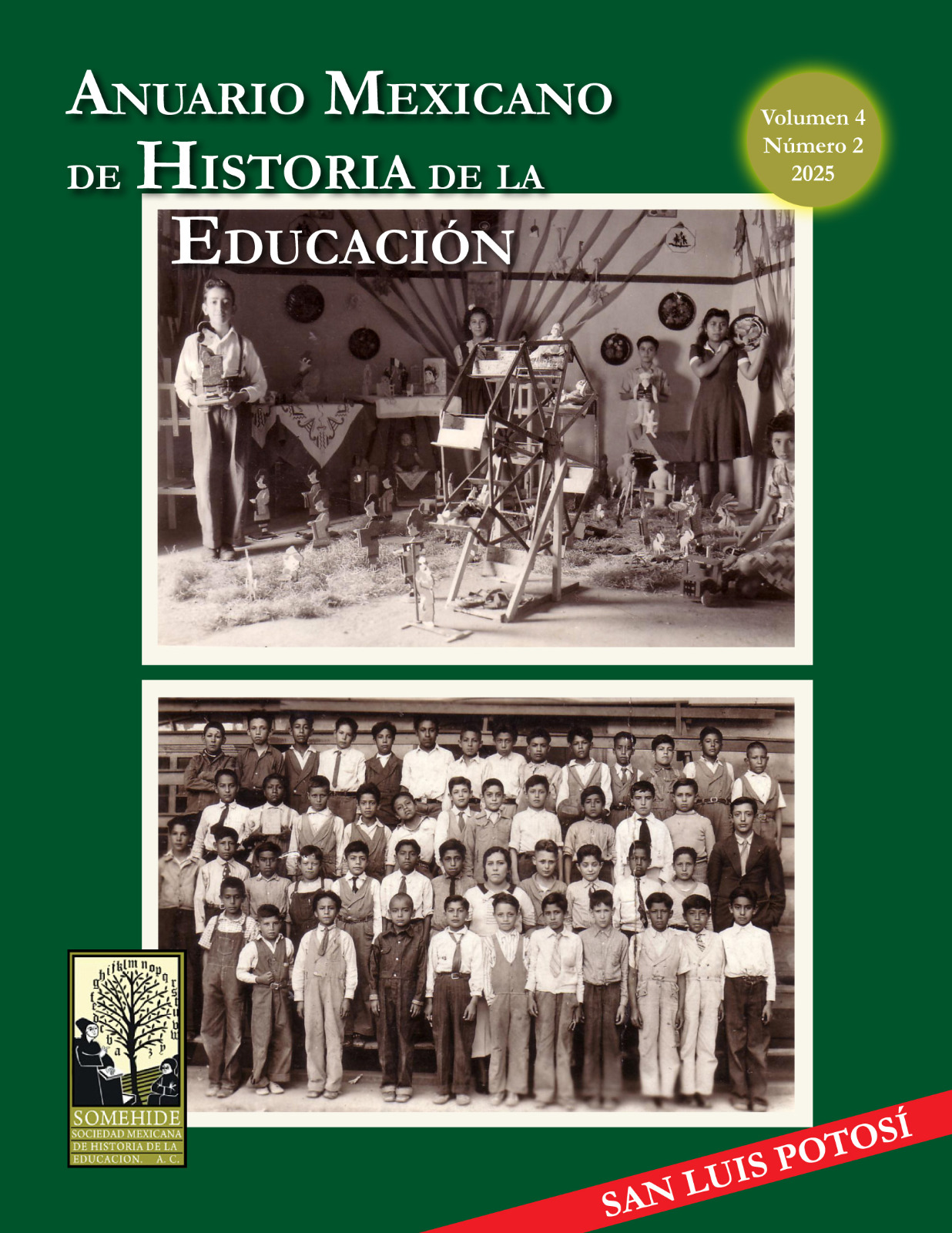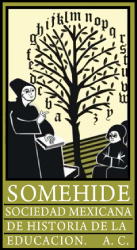Poblaciones escolares: el alumnado de la Junta de Caridad en la primera mitad del siglo XIX poblano
DOI:
https://doi.org/10.29351/amhe.v4i2.674Palabras clave:
Cultura escolar, epistemología, historia de la educación, infanciaResumen
El acercamiento a la niñez usualmente se ha realizado desde la historia social, generando el concepto de infancia, la cual difícilmente ha sido atendida por los investigadores, incluso en diversos momentos la reconstrucción de la participación social infantil se ha mezclado y en algunos casos diluido en el rescate de historias institucionales, debido a que las fuentes proporcionan un acceso sesgado a la cultura infantil, pues escasamente sus acciones y palabras quedaron plasmadas para ser vistas por generaciones futuras. La epistemología de la escolarización ha abierto nuevas vetas de investigación a partir de la historia cultural. La presente investigación busca desentrañar la sociedad e historia de las poblaciones escolares pertenecientes a las escuelas de la Junta de Caridad ubicadas en la ciudad de Puebla durante la primera mitad del siglo xix. Se rescatan las huellas escritas del alumnado masculino y femenino a través de sus listas de alumnas y cuadernos escolares, resaltando el fluctuante contexto histórico-social en que se desarrolló la instrucción, donde la constante tensión entre la Mitra y el ayuntamiento generó una serie de políticas públicas que influenciaron el currículo, siendo el método lancasteriano el punto de unión entre ambas instituciones, debido a que esta propuesta educativa juntó los valores sociales de ambas partes para la enseñanza de las primeras letras. El presente artículo muestra, en un primer momento, los esfuerzos para desentrañar la historia educativa que se ha seguido desde dos parámetros: a partir de la infancia y de las poblaciones escolares, para posteriormente establecer el contexto educativo de la ciudad de Puebla en la primera mitad del siglo xix, donde se desenvolvió la escuela femenina perteneciente a la Junta de Caridad, y finalmente se profundiza en los cuadernos del alumnado masculino y femenino de las escuelas llevadas por dicha Junta.
Citas
AHGMP [Archivo Histórico General Municipal de Puebla] (1838). Sección Leyes y decretos, Volumen 8.
AHGMP (1840). Sección Expedientes, Volumen 9.
AHGMP (1854). Sección Leyes y decretos, Volumen 17.
Aguirre Lora, M. E. (2003). Ciudadanos de papel, mexicanos por decreto. En T. S. Popkewitz, B. M. Franklin y M. A. Pereyra (coords.), Historia cultural y educación. Ensayos críticos sobre conocimiento y escolarización (pp. 297-331). Pomares.
BJML [Biblioteca José María Lafragua]. Fondo: Academia de Bellas Artes de Puebla, siglo XIX, Caja 52.
Carrillo, A. M. (2005). Vigilancia y control del cuerpo de los niños. La inspección médica escolar (1896-1913). En L. Cházaro y R. Estrada (coords.), El umbral de los cuerpos. Estudios de antropología e historia (pp. 171-208). COLMICH/BUAP.
Connaughton, B. (2012). De la monarquía a la nación en la América española: las disonancias de la fe. En M. d. P. Martínez López-Cano (coord.), La Iglesia en Nueva España. Problemas y perspectivas de investigación (pp. 381-412). UNAM.
Escolano Benito, A. (2000). Tiempos y espacios para la escuela. Ensayos críticos. Biblioteca Nueva.
Herrera Feria, M. d. L. (2006). Huérfanas, nodrizas y profesoras poblanas del siglo XIX. En M. d. L. Herrera Feria (coord.), Estudios históricos sobre las mujeres en México (pp. 251-268). BUAP.
Herrera Feria, M. d. L. (2012). Frágiles y desamparados: mujeres y niños en la ciudad de Puebla. En C. Contreras Cruz y M. Á. Cuenya Mateos (coords.), Puebla. Historia de una identidad regional (pp. 149-166). Milenio.
Herrera Feria, M. d. L. (2012). La infancia asilada en las instituciones de asistencia pública en Puebla durante la segunda mitad del siglo XIX. En M. d. L. Herrera Feria (coord.), Estudios sociales sobre la infancia en México (pp. 269-300). BUAP.
Hunter, I. (1998). Repensar la escuela. Subjetividad, burocracia y crítica. Pomares.
Márquez Carrillo, J. (2004). Historia social y cultural de la educación. Trayectoria y notas para su estudio en Puebla. BUAP.
Morales Arciniega, J. L. (2007). Oración y canto: el Colegio de Infantes de Santo Domingo en Puebla. En M. d. L. Herrera (coord.), Estudios sociales sobre la infancia en México (pp. 223-240). BUAP.
Popkewitz, T. S. (1998). La conquista del alma infantil. Política de escolarización y construcción del nuevo docente. Pomares/UNAM.
Popkewitz, T. S. (2003). La producción de la razón y poder: historia del currículum y tradiciones intelectuales. En T. S. Popkewitz, B. M. Franklin y M. Á. Pereyra (comps.), Historia cultural y educación. Ensayos críticos sobre el conocimiento y la escolarización (pp. 146-186). Pomares.
Popkewitz, T. S., Franklin, B. M., y Pereyra, M. Á. (2003). Historia cultural y educación. Ensayos críticos sobre conocimiento y escolarización. Pomares.
Rosales Salazar, M. A. (2008). La junta de caridad y sociedad patriótica para la buena educación de la juventud en Puebla. 1813-1829 [Tesis de Licencitura]. BUAP, Puebla, México.
Sánchez Pozos, C. (2007). La instrucción elemental en el Hospicio de Pobres de la ciudad de Puebla, 1826-1862. En M. d. L. Herrera (coord.), Estudios sociales sobre la infancia en México (pp. 241-268). BUAP.
Torres Bautista, M. E. (2007). La infancia de la élite profirista: los niños Maurer (1871-1890). En M. d. L. Herrera Feria (coord.), Estudios sociales sobre la infancia en México (pp. 301-312). BUAP.
Descargas
Publicado
Cómo citar
Número
Sección
Licencia
Derechos de autor 2025 Mariana Marín Ibarra

Esta obra está bajo una licencia internacional Creative Commons Atribución-NoComercial 4.0.
Todos los contenidos del Anuario Mexicano de Historia de la Educación se publican bajo una licencia Creative Commons Atribución No Comercial 4.0 Internacional (CC BY-NC 4.0), que permite compartir (copiar y redistribuir el material en cualquier medio o formato) y adaptar (remezclar, transformar y construir a partir del material) para fines no comerciales, dando los créditos a los autores y a la revista, tal como lo establece la licencia.
La política de acceso abierto y de licencias con “algunos derechos reservados” no niega la propiedad intelectual ni los derechos de los autores respecto a sus artículos, pues ellos son los titulares, en tanto que el Anuario Mexicano de Historia de la Educación no los reserva para sí ni para la institución editora, ya que se apegan a movimientos de acceso abierto como los Principios y Valores del Sistema de Información Científica Redalyc - Red de Revistas Científicas de América Latina y el Caribe, que pugnan por la eliminación de las políticas de embargo para que el autor retenga los derechos de su obra (principio número 8). Así como las políticas de acceso abierto del Directory of Open Access Journals (DOAJ).
Los autores podrán distribuir su propio material en cualquier otro medio o soporte, siempre y cuando sea para fines no comerciales, informando a los editores que el trabajo será publicado nuevamente y dando el crédito correspondiente al Anuario Mexicano de Historia de la Educación.
La publicación en el Anuario Mexicano de Historia de la Educación, por su carácter gratuito, no da derecho a remuneración económica alguna a los autores, ni a los dictaminadores.
Los lectores podrán reproducir (copiar), comunicar, distribuir o hacer obras derivadas de los artículos o colaboraciones publicados en el Anuario Mexicano de Historia de la Educación en los siguientes casos:
- Para fines públicos.
- Sin fines comerciales.
- Que se reconozca la autoría de la obra y se cite su origen con información completa: Apellido/s del autor, inicial/es del nombre/s. (año de publicación). Título del artículo. Nombre de la revista, volumen (número de ejemplar), página inicial del artículo-página final del artículo. DOI o URL (formato sugerido de acuerdo al estilo APA en su versión más reciente).
El cuerpo editorial del Anuario Mexicano de Historia de la Educación asumirá el compromiso de notificar oportunamente a los autores sobre cualquier cambio de ubicación de los artículos en el sitio (cambio de dirección URL o de conexiones para identificar el artículo).
Los autores, al enviar sus trabajos para su posible publicación, deberán tomar en cuenta los puntos anteriores, mismos que se contemplan en el Acuerdo entre autor y el Anuario Mexicano de Historia de la Educación.












